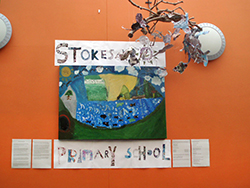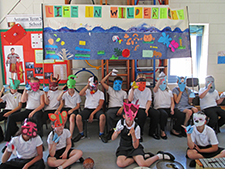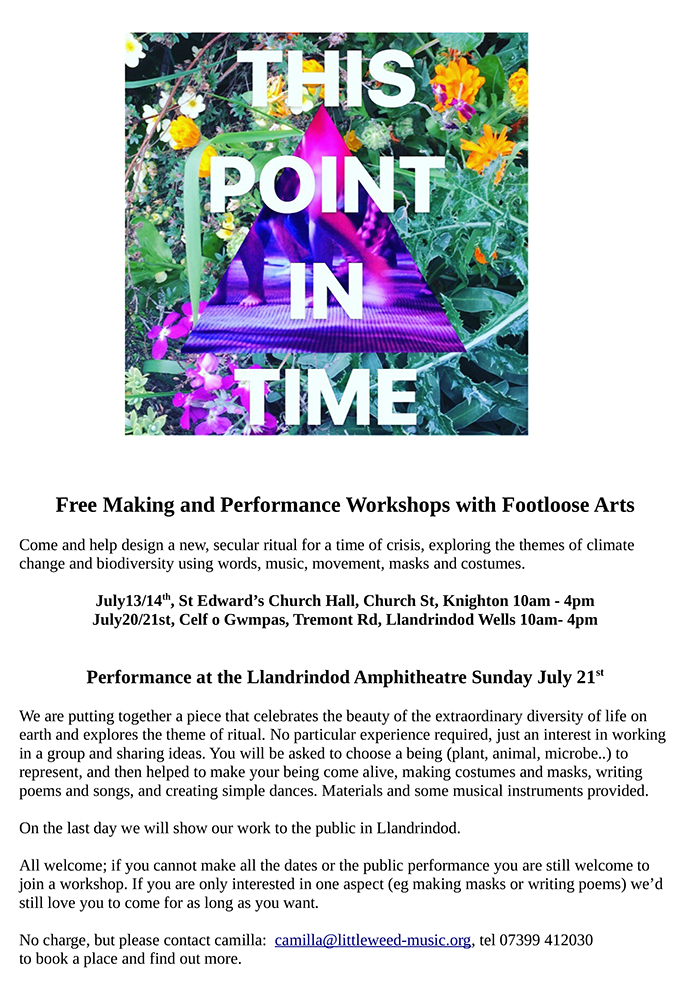


The aim of the overall project is to explore several different habitats in the UK, in order to create music and art inspired by them, at the same time as increasing knowledge about nature and biodiversity.
There are many wonderful nature films, and excellent information on websites, but seeing a film made by others is not the same as looking down a microscope yourself at tiny organisms that you never knew existed, or walking through a landscape while being told about its geological and cultural history by an informed expert.
A surprising number of children - rural as well as urban - spend very little time out of doors, and Footloose wants to create opportunities for children and adults to celebrate the wonderful biodiversity of life using music and visual art. In the Age of the Anthropocene, we need to re-connect with the beauty and magic of the natural world, recognising ourselves as part of it, not outside or in control, but intertwined and interdependent.

Life on the Long Mynd
This project involved twenty children from Year 5, Stokesay Primary School, working with artist Ciara Lewis, and musician Camilla Saunders, from Footloose Community Arts. Thanks to the Shropshire Hills AONB whose funding made it possible.
The project spanned three days and the first day was spent at Carding Mill, with leaders from the National Trust's educational team.
We all had a very productive and enjoyable time. The children were divided into two groups and alternated doing the same activities: pond, or rather stream-dipping, and then identifying animals with the help of magnifying glasses and microscopes; looking for and identifying woodland bugs and insects; an afternoon walk for about an hour that led us through geological space and time, with information about the history of Carding Mill as well as some of the flora and fauna we saw. The geology of the Long Mynd is fascinating, as it tells the story of volcanic eruptions, tectonic plates clashing, and the movement of Ice Age glaciers.
Some of the day - especially the walk - was quite challenging for some of the children, but they all managed to do everything and felt pleased with themselves afterwards. Apparently very few of them had actually been to Carding Mill, or the Long Mynd in general, even though they live a short journey away.
We then had two whole days in school with the children, starting with a discussion about what we had observed and experienced. We divided into two groups alternating activities, as before.
Each group contributed to a painted landscape picture, learnt to do paint-marbling on paper, and made mobiles based on some of the creatures we had seen. These activities sparked the children’s imagination and developed their skills of designing and making.
At the same time the other group worked on music. This involved making up group songs about the day at Carding Mill, and composing percussive pieces (one each group) based loosely on the painting and our experience of the landscape. As it was the last week of the summer term the energy was quite high. Some of the children had quite short attention spans, and a tendency to whack the percussion as hard as they could without much reference to what was happening around them. However, they all helped each other and managed eventually to focus and produce some excellent work.
In the process, they learnt about conducting and dynamics; using rhythm, both with percussion instruments and with voices; composing songs; and – most importantly - working together creatively as a group.
All the art work and music were based on what we had experienced or discovered at Carding Mill.
At the end of the second day the children did a presentation, for the school and family members, standing in front of their art work and performing the songs and percussion pieces.
All the children would benefit with more time engaged in such activities, and some of them, with enough support, could be extremely proficient. They also really benefited from the outdoor practical learning. Some of these children spend very little time out of doors, despite living in a rural area. They have been given an insight into one landscape and the different life forms that it supports. This is very different to learning from books or the internet. The opportunity to look at small creatures in detail, with experts on hand with specialist knowledge, is very special and not part of routine primary education. Without the SAONB grant, they would not have had this experience.
Their art work is being exhibited in the Discovery Centre nearby in Craven Arms, and will be returned to the school later this term.
The school staff were really enthusiastic about the project and keen to work more together if we can source further funding.
The following statement was made by the school teacher with whom we worked:
'Your positivity and encouragement of their ideas and creativity was brilliant and so what the children need.
'The whole experience really opened their eyes to the environment and considering we live in a rural area, it was surprising how many new experiences the children took part in through our day at Carding Mill.'
And an audience member: 'It was an interesting and remarkable experience to see young children without earlier training in music, and little time to prepare, give a performance that was enjoyable and cute. Good teachers I must add.'
NT staff: All NT staff who worked with the students thought they were excellent. All having a really good go at all the activities and producing some great results. It will be great if we can run this again next year.
And from the children:
Thank you, I really enjoyed everything. My favourite part was the walk, because I learnt loads of things.
Thank you ..all of it was my favourite.
My best bit was the marbling because it was really fun.
We loved looking at the creatures and around Carding Mill.
My favourite part was the music and art.
We made real cool designs.
My favourite would have to be making the marble paper and being able to play lots of amazing percussion.
I like messy art...
Making the mobiles was just so relaxing!
Thanks to the children and staff of Stokesay School, staff at the Discovery Centre where we put up the exhibition, to Shropshire SAONB for the funding, and special thanks to the staff and educational department at The National Trust who gave us an informative and exciting day.
Stokesay School and Wilderhope
Following on from the Long Mynd project last year, fifteen Year 5 children from Stokesay School visited Wilderhope where they spent a day with National Trust rangers, learning about the area, its history and wild life. They did pond-dipping, walked, observed, and heard stories from Elizabethan times.
This was followed by two and a half days of creative workshops at school. The children made masks inspired by their day at Wilderhope, wrote a group poem, and devised music and movements based on their mask identities, making use of a range of percussion instruments at the school.
We had a wall (there is a fine Elizabethan manor house at Wilderhope) being pushed over by two stomping bulls, a butterfly, ladybird, snakes, a goat, sheep - even a leaping dragon and two dancing unicorns ... they also made snapping bird-like creatures used to great effect to suggest the sound and movement of bird wings.
The children worked hard and came up with a range of inventive sounds and movements. Our facilitation was light-handed and this was very appropriate for this group.
The project ended with a presentation for parents and other Key Stage 2 children. This caused some pre-performance nerves but they managed well.

We liked the freedom to try different instruments and different ideas. Really enjoyed making the masks. They were fun.
Enjoyed making the finger puppets and masks. Enjoyed playing cymbals to make sounds like the rain and trees.
Liked being able to choose what art they could do.
The poem:
Glamorous reflection
Twinkling river shining blue
Dripping, slipping
Shimmering, flowing water
This kind of project is important, as, despite living in a rural area, many children do not habitually go for walks with their families or spend much time actively observing nature. The National Trust rangers are brilliant at opening the minds of children to new experience and do not let them get bored. During the creative workshops, children are encouraged to think for themselves. They also learn about co-operating in a group.
Linking experience of the natural world with creative activities gives children the opportunity to reflect on and interpret the experiences they have outside. Ideally this kind of activity would not be a short term one-off event but occur on a regular basis as part of the curriculum. Research has shown that being outside in nature is vital for everybody's health and well-being, but especially for children, who now face distractions from computers and technology that did not affect earlier generations, and, due to an increasingly risk-averse culture, generally spend less time playing out of doors.
Every child has the right to be outside, to experience beauty, and to interpret their experience through meaningful creative activity. Both being outside and doing art and music increase overall learning skills, and help with concentration and focus. It is vital that national and local authorities recognise the importance of these activities and give schools the incentive and support to make them an essential part of the curriculum.
listen to a recording of the children's song
This Point in Time
As well as working with Stokesay School, 2018 saw the establishment of a 'Wild Choir', which gave two performances at Gilfach Nature Reserve, near Rhayader. This included improvisation, as well as a piece in praise of the earth, and a song about lichen.
2019 - supported by a donation from Llandrindod Town Council, we are holding two weekends of workshops, in Knighton and Llandrindod, 'This Point in Time'. Participants will join in creating a secular ritual/performance, exploring our responses to climate change and the current ecological crises. Anybody over the age of 7 is welcome to come and share ideas and creativity.

Please contact Camilla Cancantata to find out more.










